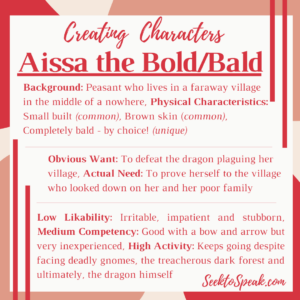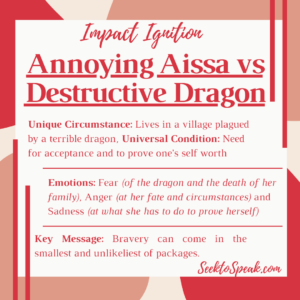In the second installment of this series, we will look at how to develop engaging characters that your audience will root for. We will also look at the kind of impact you want to generate with your story and how best to reach that impact. See here for the first installment on developing a plot.
Always remember that these tips are meant to apply to stories that are told in speech form so the characters and plot share should not be too convoluted or complicated. Unlike in a book where you can reread passages, storytelling speeches are short and fleeting, meaning it has to be delivered well the first time in order for it to be understood and remembered.
Characters
Your story’s characters are essential in ensuring that the audience is enthralled by the tale you spin. The audience is only interested in your story in so far they are invested in the characters. If they are indifferent towards the characters, they will also be indifferent to the character’s fate, and disinterested in the story altogether.
1) Visualize the Characters
Visualizing your characters in a speech means creating pictures in the mind of the audience of the character’s background and physical characteristics. There should be enough details given for the characters to come alive but not too much to allow the audience to exercise their own imagination.
These details should include the basic background of your character. Is he/she a high schooler, a single parent or a struggling actor? The life of the protagonist needs to be encapsulated in just a few words. This is also where the characters are given basic physical characteristics. Characters should be given 2 ordinary physical characteristics and 1 memorable one. This allows the character to be visualised by the audience with the help of a memorable identifier. Again, this has to be short and sweet.
For example,
Harry Potter
Background: Orphan boy living with stepfamily
Physical Characteristics: Black straight hair (Ordinary), round glasses (Ordinary) and a scar-shaped scar on forehead (Unique)
Elsa
Background: Orphan queen with ice powers
Physical Characteristics: Long blond hair (Ordinary), blue eyes (Ordinary) and always wore gloves (Unique)
2) Show their Wants and Needs
This is probably the most important decision to make about your characters – their wants and needs. Wants are the character’s thoughts, opinions, and dreams while Needs are the truth and reality of the circumstances. The character’s wants would be explicitly shown in the story. It might be to avenge a loved one, to get into a school of their dreams or to start an adventure. The character’s Needs are implied and internal, typically only revealed much later in the story when the character realizes it herself/himself.
For example,
In Spiderman (Homecoming), Peter Parker wanted desperately to be part of the Avengers and save the world. However, what he actually needed was a sense of purpose given that he had special powers.
In Cinderella, Ella wanted to attend the ball and hopefully catch the eye of the prince but what she actually needed was love and happiness, a way out of her life.
A Want is made obvious in the story but a Need is something the character develops along the way. It’s important to be aware of a character’s wants and needs as this is how you create obstacles and challenges to develop the character. This can come in the form of evil villains, financial hardships or inexperience.
3) Likeability, Competency, and Activity
Henry Boseley, from the Closer Look, argues that a good character has various degrees of Likeability, Competency, and Activity. Likeability means the character’s relatability, humor, and ethics. A character is generally likable if you think that character would a great person to be friends with. Competency is the character’s aptitude, skill, and experience. A character is competent if he/she is an expert in something. Activity is the character’s efforts, industry and struggles to achieve his/her goals. This is the character’s journey or quest in the story.
For example,
Characters like Mulan, Frodo, and Ron Weasley have high likeability, high activity but low competency. Characters like Batman, Darth Vader, and Sherlock Holmes have low likeability but high competency and activity.
However, these characters are all memorable and engaging in their own way.
It is important to ensure that characters do not have high likeability, competency AND activity because they are harder to relate to. Not a lot can be thrown their way to be “better persons”. Characters with high likeability, competence and activity are considered “Mary Sues” which are characters that are too perfect to be engaging. They are extremely skilled, well-liked and able to reach their goals with minimal effort. These include characters like Superman, James Bond, and Bella Swan. They come off as unrealistic and sometimes even annoying.
Applying the above, an example of a Character draft would be:

Impact
It is important to determine what kind of impact you want to have with your story. Impactful stories are those that are uniquely universal, emotionally driven and contain a key message.
1) Uniquely universal
I know it sounds counterintuitive – how can a story be both unique and universal? Well, great stories take a common human condition that everyone experiences and conveys it in a unique way. A process I like to call, Universal Experiences in Unique Circumstances. This makes the story relatable yet interesting at the same time. Universal experiences include growing up, falling in love or learning a lesson. The unique circumstances in which such experiences exist is completely up to the speaker.
For example,
Harry Potter’s unique circumstance is being orphaned by Voldermort and going to magic school. His universal condition is going to school, making friends and coming to terms with his loss.
Batman’s unique circumstance is being an orphaned millionaire dedicating his life to vigilante justice. However, his universal condition is the need to seek justice and to stop from feeling powerless.
This is similar to when we discussed the Wants and Needs of characters. Wants are typically unique to the story but Needs are typically universal.
For example, in Spiderman (Homecoming), Peter Parker’s unique want is to join the Avengers but his universal need is to have a sense of purpose.
2) Emotionally-driven
Unlike informative speeches, stories should be emotionally charged. It is important for the audience to feel something about the story and its characters. This keeps them engaged during the story and ensures that the tale is remembered long after you have delivered it.
As I have discussed in my previous post here on the Element of Emotion, humans are social creatures and emotions heavily influence our actions and thoughts. Emotions are contagious, a phenomenon known as “Emotional Contagion”, in that we tend to mimic or get affected by the emotions of the people around us. If we can generate the right type of emotion during our speech and enough people feel something, the effect could spread like wildfire across the room.
In a story, I suggest trying to connect with at least two of the Six Basic Emotions shared by all of us, i.e. anger, fear, happiness, sadness, disgust, and surprise. Great stories have a good mix of several emotions, allowing the audience to feel more than just one thing at once.
For example,
The movies, Frozen, Star Wars, and Titanic all had a good mix of sadness, fear, and happiness.
An emotional connection is best established through great non-verbal cues like your intonation, facial expressions, and hand gestures.
3) Key Message
After analyzing 200 of the best TED talks, Akash Karia, a presentation expert, found that a positive resolution is important in a speech. In a story, this comes in the form of a key message, typically delivered as a lesson learned, a point of reflection or a call to action. These usually stem from the discovery of the characters’ actual need and the audience’s relatability to the universal experience shown in the story. It doesn’t strictly have to be, “The moral of the story…” type narrative. It can be explicitly narrated in the story, implied from the character’s journey or uniquely contemplated by the audience.
For example,
In the movie, Joker, it is the realisation that cruelty breeds more cruelty. In the documentary, the Gamechanger, the narrator challenges people to adopt a vegetarian lifestyle. In Toy Story 4, it is the lesson of letting go.
Applying the above, an example of how I want my audience to be impacted is:

